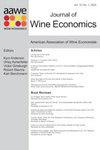葡萄酒排名和博尔达法
IF 1.6
4区 经济学
Q2 AGRICULTURAL ECONOMICS & POLICY
引用次数: 0
摘要
我们建议根据博尔达规则,使用取决于对每种葡萄酒的有利和不利意见之间差异的分数来建立葡萄酒排名。与其他方法和规范不同,即使小组成员的质量关系不需要表现出传递性或非循环性等苛刻的特性,这种方法也是定义明确的。例如,我们将该方法应用于不同专家评估的葡萄酒排名,并将结果与根据Condorcet的多数投票法获得的排名进行比较。本文章由计算机程序翻译,如有差异,请以英文原文为准。
Wine rankings and the Borda method
We propose to establish wine rankings using scores that depend on the differences between favorable and unfavorable opinions about each wine, according to the Borda rule. Unlike alternative approaches and specifications, this method is well-defined even if the panelists’ quality relations are not required to exhibit demanding properties such as transitivity or acyclicity. As an illustration, we apply the method to rank wines assessed by different experts and compare the resulting ranking with that obtained according to Condorcet's method of majority voting.
求助全文
通过发布文献求助,成功后即可免费获取论文全文。
去求助
来源期刊

Journal of Wine Economics
Agricultural and Biological Sciences-Food Science
CiteScore
3.20
自引率
28.60%
发文量
33
期刊介绍:
The Journal of Wine Economics (JWE), launched in 2006, provides a focused outlet for high-quality, peer-reviewed research on economic topics related to wine. Although wine economics papers have been, and will continue to be, published in leading general and agricultural economics journals, the number of high-quality papers has grown to such an extent that a specialized journal can provide a useful platform for the exchange of ideas and results.
The JWE is open to any area related to the economic aspects of wine, viticulture, and oenology. It covers a wide array of topics, including, but not limited to: production, winery activities, marketing, consumption, as well as macroeconomic and legal topics. The JWE has been published twice a year and contains main papers, short papers, notes and comments, reviews of books, films and wine events, as well as conference announcements. From 2013 on, the JWE has been published three times per year.
The Journal of Wine Economics is fully owned by the American Association of Wine Economists (AAWE) and, since 2012, has been published by Cambridge University Press.
 求助内容:
求助内容: 应助结果提醒方式:
应助结果提醒方式:


